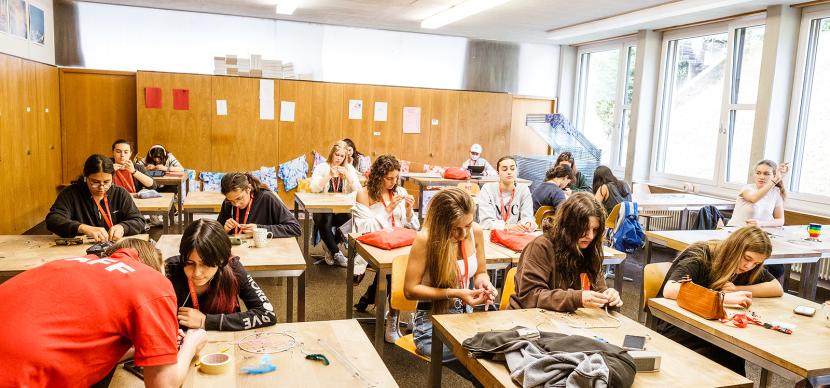Can Being Bilingual Make You More Creative?

We already know that learning a language can do some amazing things for your brain: help you tune out distractions, multitask and even delay the onset of diseases like Alzheimer’s. But what about creativity? Isn’t language learning just about accumulating and sorting knowledge, not coming up with anything new? There have always been great well-travelled and/or bilingual artists – Pablo Picasso, Frida Kahlo, Vladimir Nabokov, or, in our own era, filmmakers such as Guillermo del Toro and Ang Lee, or musicians like Regine Chassagne, Camila Cabello and Shakira. But could their time immersed in a second or third language actually have helped them create better art?
According to psychologists and linguists, maybe so. The benefits of learning a language – especially when accompanied by travel abroad – may go even further than we thought.
A world of possibilities
How many uses can you think of for a brick? Obviously a brick is supposed to be used for building walls but you could also use it as a paperweight, a door stop, a book-end…or for more sinister purposes –to break a window or to weigh down incriminating evidence you want to throw into a canal. It could even be something whimsical – you could write “Fluffy” on it and make it a tombstone for a pet hamster…
Developed by J.P Guilford in 1967 this test is one tool psychologists use to measure “divergent thinking,” an indicator of creativity. Rather than focusing on accuracy or logic, the test examines the following four abilities:
- Fluency: The number of responses you can come up with reveals something about how easily you can generate ideas without getting stuck.
- Originality: How imaginative and unusual are the ideas? “Getting rid of evidence” would get more points than “a door stop.”
- Flexibility: “Door stop” and “bookend” are rather similar. Solving completely different types of problems scores higher than a lot of different variations on a theme.
- Elaboration: The level of detail also counts, so Fluffy’s headstone shows more creativity than “paperweight.”
Try it now – how many uses can you think of for a paperclip? Give yourself just two minutes and see how creative you are!
According to Professor Colin Baker of Bangor University, bilinguals tend to perform better on tests like this. He suggests that having two or more words for one idea may improve elasticity in thinking, the word “ysgol” in Welsh means both school and ladder, so a Welsh/English bilingual’s idea of “school” gains an extra dimension. Writer Ivan Miguel makes a similar point:
"Examine the case of rainbow, which is arcoiris in my native language. In English, it's a bow made of rain, while in Spanish it's an arch (arco) made of the spectrum of light (iris). But you need rain and light to make a rainbow. Each language saw the same phenomenon, but only 50% of each made it to their word."
The Spanish/English speaker can see the arch and the bow, the rain and the light. This may make it easier to look at a concept from multiple angles, increasing the range of possibilities you can see in something as simple as a brick.
Making something out of nothing
Take this shape and make it part of a drawing.

What can you turn it into? We could add a few lines and …

It’s a boat! But it’s pretty basic. We asked some arty types around the office to see what they could come up with after spending a few minutes playing with the shape.
This challenge is a key feature of the Torrance Test of creative thinking, and as with the “uses for a brick” test, researchers look for detail and elaboration, as well as assessing whether the picture tells a story.
At the University of Mashhad, Behzad Ghonsooly and Sara Showqi administered the Torrance Test to monolingual students and students who had acquired an advanced level of fluency in English. Even when they controlled for IQ and economic status, the results were clear:
“The findings revealed that learning English as a foreign language to an advanced level significantly enhances all four divergent thinking abilities.”
Ghonsooly and Showqi believe the reason for this may reflects something many foreign language students know intimately from experience. Learning English exposed the bilingual students to “cultures, customs, and beliefs distinctive from their own,” and this broader world-view allowed more scope for creativity.
Soaking up the details
Is the link between an international outlook and creativity detectable in the real world? According to Professor Adam Galinsky at Colombia Business School, yes. Galinsky claims that travel also boosts creativity – but only when it’s a truly immersive experience. You need to be surrounded by new sights and sounds, new ideas and new language to benefit.
"The key, critical process is multicultural engagement, immersion and adaptation. Someone who lives abroad and doesn't engage with the local culture will likely get less of a creative boost than someone who travel abroad and really engages in the local environment."
Galinsky’s team examined the work of 270 fashion houses over a full eleven years. He asked experts such as trade journalists and buyers to rate the fashion lines for creativity – and once again, found a clear link. Creative directors who had lived and worked abroad produced more original and imaginative fashion lines than those who had stayed at home.
So if you’ve always wanted to write, paint or make music but find yourself low on inspiration, perhaps it’s time to learn a language abroad. Who knows what you’ll create from the experience?
 617 275-5955
617 275-5955


